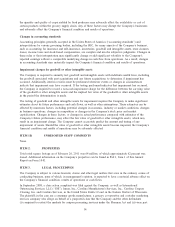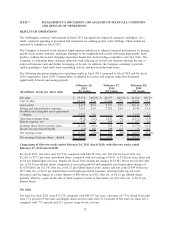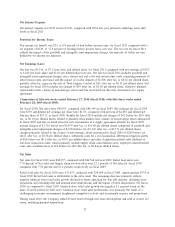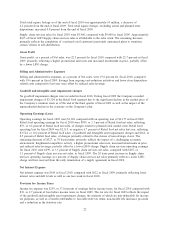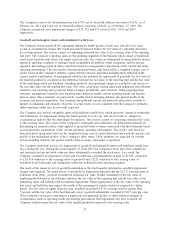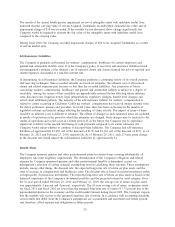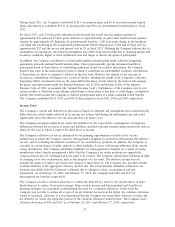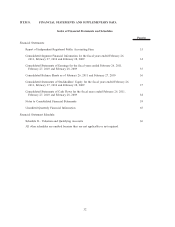Albertsons 2011 Annual Report Download - page 28
Download and view the complete annual report
Please find page 28 of the 2011 Albertsons annual report below. You can navigate through the pages in the report by either clicking on the pages listed below, or by using the keyword search tool below to find specific information within the annual report.total vendor funds earned, including advertising allowances, with no offsetting changes to the base price on the
products purchased, would impact gross profit by less than 10 basis points.
Inventories
Inventories are valued at the lower of cost or market. Substantially all of the Company’s inventory consists of
finished goods. Approximately 79 percent of the Company’s inventories were valued using the last-in, first-out
(“LIFO”) method for fiscal 2011 and fiscal 2010. The Company uses a combination of the retail inventory
method (“RIM”) and replacement cost method to determine the current cost of its inventory before any LIFO
reserve is applied. Under RIM, the current cost of inventories and the gross margins are calculated by
applying a cost-to-retail ratio to the current retail value of inventories. Under the replacement cost method, the
most current unit purchase cost is used to calculate the current cost of inventories. The first-in, first-out
method (“FIFO”) is used to determine cost for some of the remaining highly perishable inventories. If the
FIFO method had been used to determine cost of inventories for which the LIFO method is used, the
Company’s inventories would have been higher by approximately $282 and $264 as of February 26, 2011 and
February 27, 2010, respectively.
During fiscal 2011, 2010 and 2009, inventory quantities in certain LIFO layers were reduced. These reductions
resulted in a liquidation of LIFO inventory quantities carried at lower costs prevailing in prior years as
compared with the cost of fiscal 2011, 2010 and 2009 purchases. As a result, Cost of sales decreased by $11,
$22 and $10 in fiscal 2011, 2010 and 2009, respectively.
In addition, the Company evaluates physical inventory shortages throughout the year based on actual physical
counts in its facilities. Allowances for inventory shortages are recorded based on the results of these counts to
provide for estimated shortages as of the financial statement date. Although the Company has sufficient
current and historical information available to record reasonable estimates for inventory shortages, it is
possible that actual results could differ. As of February 26, 2011, each 25 basis point change in the estimated
inventory shortages would impact the allowances for inventory shortages by approximately $14.
Reserves for Closed Properties and Property, Plant and Equipment-Related Impairment Charges
The Company maintains reserves for costs associated with closures of retail stores, distribution centers and
other properties that are no longer being utilized in current operations. The Company provides for closed
property operating lease liabilities using a discount rate to calculate the present value of the remaining
noncancellable lease payments after the closing date, reduced by estimated subtenant rentals that could be
reasonably obtained for the property. The closed property lease liabilities usually are paid over the remaining
lease terms, which generally range from one to 20 years. The Company estimates subtenant rentals and future
cash flows based on the Company’s experience and knowledge of the market in which the closed property is
located, the Company’s previous efforts to dispose of similar assets and existing economic conditions.
Adjustments to closed property reserves primarily relate to changes in subtenant income or actual exit costs
differing from original estimates. Adjustments are made for changes in estimates in the period in which the
changes become known.
Owned properties, capital lease properties and the related equipment and leasehold improvements at operating
leased properties that are closed are reduced to their estimated fair value. The Company estimates fair value
based on its experience and knowledge of the market in which the closed property is located and, when
necessary, utilizes local real estate brokers to assist in the valuation.
The expectations on timing of disposition and the estimated sales price or subtenant rentals associated with
closed properties, owned or leased, are impacted by variable factors including inflation, the general health of
the economy, resultant demand for commercial property, the ability to secure subleases, the creditworthiness of
sublessees and the Company’s success at negotiating early termination agreements with lessors. While
management believes the current estimates of reserves for closed properties and related impairment charges
are adequate, it is possible that market and economic conditions in the real estate market could cause changes
in the Company’s assumptions and may require additional reserves and asset impairment charges to be
recorded.
24


